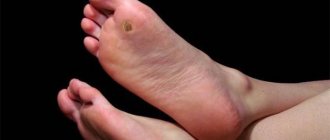How to get rid of thorny
The information below is general (for informational purposes only) and cannot be used to make a decision on the use of any specific drug or preparation of a folk remedy.
Spipiga (thorn or wart, similar to a callus) is a skin disease of a viral nature.
To remove the growth, you need to start treatment with the most important, large formation.
What is a thorn
Doctors believe that the spine (spike) is the result of the activation of one of the strains of papilloma. Externally, the growth resembles a wart, and in the early stages - a callus, but has significant differences from the latter. It has been established that even with active treatment, there is a possibility of relapse on the toe or in other places where the spine previously appeared. This type of wart is a difficult-to-treat illness and is fraught with dangerous consequences if the patient starts the disease or tries to do without qualified medical care.
What does it look like
Immediately after infection with the papilloma virus, a small yellowish skin lump appears on the toe. Externally, the spine resembles a callus formation. However, unlike a callus, a callus causes serious pain when walking. After 5-10 days, the tubercle grows. If you do not take urgent measures to remove the tumor, the spine begins to grow, capturing nearby tissues, and affects the entire sole, making walking extremely difficult. Multiple clusters of warts appear on the skin.
How is it different from a callus?
Many patients suspect that they have a bunion and do not know how to distinguish a regular callus from a bunion on the toe caused by papilloma. The main difference between a spine and a callus is the presence of long root threads that quickly grow deep into the epidermis, and then it is very difficult to remove them using conventional methods. In addition, the disease develops rapidly - within two weeks the first full-fledged wart is formed, then daughter formations appear on the skin, growing from the root threads. The pain from a papilloma growth is much more serious than from a callus.
What does it come from?
The papilloma virus is the main culprit in the growth of warts on the skin of the toes. However, it is believed that for many people this virus is present in the body a priori, and only under the influence of external unfavorable factors does it begin to become active and painful neoplasms appear on the skin. The reasons for the appearance of this type of wart are as follows:
- Constantly wearing tight and uncomfortable shoes, sweating feet.
- Walking barefoot where there is a high probability of “catching” the papilloma virus - in swimming pools, saunas, baths, and other places characterized by high humidity.
- Weakened immunity of the body due to past viral and bacterial diseases.
- Constant stress, depression, lack of sleep.
- A side effect of antibiotic therapy or chronic illnesses of various etiologies.
Reasons for education
The main cause of all skin tumors is infection with papillomavirus. Today this virus is one of the most widespread. HPV is diagnosed in 90% of the population.
Once in the circulatory system, the papillomavirus penetrates epithelial cells, changing their DNA and provoking accelerated growth. As a result, growths appear.
Important! HPV cannot exist outside the human body for long. A warm, moist environment prolongs its “life.”
That’s why it’s so easy to “catch” the virus on benches, locker rooms, handrails of public baths, swimming pools, saunas or baths. But you can walk barefoot on the beach completely freely. When exposed to sunlight, papillomavirus cells die instantly.
Symptoms
It is impossible not to notice that walking has become more painful due to a growth on the foot. The patient initially believes that it is a callus. The appearance of a spine on a toe or foot is characterized by the following symptoms:
- 2-3 days after the spine appears, it begins to grow, acquires a darker shade, and pain appears.
- Dissection of the warty formation occurs.
- Dark “roots” appear in the center, threads going deep into the epidermis of the finger.
- After 5-7 days, the spine looks like a volcano crater with a black or dark middle, which is made up of threads.
- In the absence of proper therapy, many subsidiary formations appear, which can cover the entire finger or leg.
- Stepping on a foot affected by a skin disease becomes more and more painful.
Symptom complex
The symptoms of spine development are quite difficult to confuse or not notice. First, a small yellowish spot appears on the sole or heel. Over time, it grows and resembles a dense nodule with a rough surface.
The growth acquires clear boundaries, raised at the edges. At this time, unpleasant symptoms such as burning or itching are observed. This is caused by irritation of the nerve endings of the deep layers of the dermis.
If therapy is not started, the wart turns into a dense nodule with internal roots. At this time, the person begins to experience pain when walking.
If you remove the upper keratinized layer of the growth, dark inclusions become noticeable. These are capillaries that have become clotted due to an overgrown wart.
Spine treatment
Papilloma is considered the most complex skin neoplasm, which is not easy to combat - there is always the possibility of a relapse of the disease, since the roots of the wart can go into the deeper layers of the skin, from where it is very difficult to “get” them. Doctors practice a variety of methods for treating such warty growths, and they all boil down to removing the spine on the toe or foot in one way or another. Medical intervention involves the following methods to destroy growths:
- surgical;
- laser;
- electrocoagulation;
- chemical;
- radio wave.
These measures help get rid of the painful formation immediately. Another thing is an attempt at treatment at home, when patients try to remove a wart using non-surgical methods. This may take 3-4 days and the effectiveness of such therapy is low, since if the condition is neglected, it will not be possible to remove the roots using any home methods; they can sprout again on a leg or finger, causing a lot of inconvenience.
Which doctor should I contact?
Skin diseases should be treated by a dermatologist, who will suggest the most rational ways to get rid of the disease, conduct a visual examination, and, if necessary, take a scraping of the tumor for analysis. All dermatologists warn that formations based on the papilloma virus can turn into malignant tumors if the place where they appeared is constantly injured, infected, and is not exposed to medical intervention.
Methods for removing spines
There are many modern effective measures to get rid of a bunion on the toe. With their help, you can remove it forever. Doctors use the following methods to remove a bunion on a toe:
- Exposure to laser. This method of removal is considered the least traumatic and effective - the operation is performed with local anesthesia, and exposure to high temperature burns out all new growths along with the roots in the deep layers of the skin in a short time. Point penetration of the laser does not injure the intact surface and is capable of removing all accumulations of warts along with the papilloma virus.
- Chemical method. This method involves the chemical effect of acetic, nitric or salicylic acid on the tumor. It is not used in hospital settings due to low efficiency. After chemical removal, scars form.
- Electrocoagulation effect. A high frequency current is applied to the wart growth, burning out the entire formation along with the deep roots.
- Surgical removal. The dry callus is cut off with a scalpel under local anesthesia.
Patch
To get rid of an unpleasant tumor, you can use the Salipod patch. Steam the spine, apply an adhesive plaster to clean and dry skin, removing the film from it. It is not recommended to remove the patch for 2-3 days; you should not wet the sore spot. After this period, remove the patch - it should come off along with the wart. If this does not happen, then repeat the procedure 3-4 times.
Ointment
Non-invasive treatment involves the use of chemically active components that would help destroy common warts and plantar warts. The following special preparations can be used:
- Roaccutane. The ointment is a keratolytic and dissolves dead skin cells of the epidermis. If you lubricate the spine with it, the plantar wart peels off in parts.
- Feresol. The phenol contained in the product is used to burn the spine, which then falls off.
- Verrucacid. Has a bactericidal and cauterizing effect. When used, you can remove the upper part of the growth, which falls off along with the roots of the spine.
- Diverticular disease of the colon
- Laser removal of ingrown toenails
- Cheat meal - what is it in weight loss, how to organize it correctly
Contraindications
Contraindications for using vinegar when removing a spine are:
- Multiple papules
- Allergic reaction to vinegar.
- The location of nodes on visible areas, such as the face and eyelids.
- The presence of inflammation or ulceration around the wart.
- Children's age up to 5 years.
- Multiple spines.
It is also not recommended to remove the spine with vinegar if the color of the wart changes, its uneven edges are unclear, or blood or pus is discharged. In this case, it is better to remove warts by cauterization with liquid nitrogen.
How to get rid of spines using folk remedies
In the early stages of the disease, it is possible to get rid of the skin disease using a variety of traditional methods. However, almost all such methods are fraught with injury to intact tissues, which can then become infected and inflamed, provoking a relapse of the disease. To get rid of the growth, use the following means:
- vinegar;
- garlic or onion;
- tincture of celandine;
- horseradish;
- potato;
- nettle or burdock leaves.
Vinegar
You need to take 1 tbsp. l. flour and 1 tsp. 9% vinegar, mix well to make a paste. The mixture is applied to the affected fingertip, sealed with an adhesive plaster. Do not remove or wet your finger for 3 days. The wart should dry out and fall off, leaving a small hole in the skin, which will then heal. The method is effective for a small number of tumors.
Garlic
You need to cut a hole in the medical plaster to the size of the spine and stick it on your finger. Place a chopped clove of garlic on top and seal with another layer of plaster to secure it. After a day, remove the compress from your finger and apply a new one. After 4-5 days, the neoplasm should disappear. It has a bactericidal, antiviral, cauterizing effect on the growth.
Celandine
You can try to remove the neoplasm with liquid celandine juice. Care should be taken when using to avoid getting burned. Apply celandine juice to a clean and dried finger surface and wait until the product dries. The extract has a cauterizing effect, but you will have to repeat the procedure 5-6 times for the tumor to dry out and fall off.
Horseradish
Wash, peel the horseradish root, mince. Since the product has a strong burning effect, you need to protect the intact surface of the finger by sealing it around the tumor with an adhesive plaster, leaving a hole in the center. Apply the paste in a thick layer to the wart and secure with a band-aid. Leave the compress on overnight, then remove it in the morning, clean the skin of the toe, and repeat the procedure until the spine completely disappears.
Potato
To make the thorn on your toe disappear, you can take a raw potato and grate it. The paste is applied to each growth, covered with gauze, and then fixed with a band-aid. It is not possible to get rid of the tumor immediately using this method; the procedure is repeated for 10-14 days every day, in the mornings and evenings, to achieve the desired effect.
Related factors
Even direct contact with an HPV carrier does not always lead to infection. And from infection to the first manifestations it often takes several months or years. Why is this happening?
The duration of the latent period of papillomavirus depends on the state of the body's defenses. The higher the immunity and the stronger the immune response to a viral attack, the longer the HPV will remain in “sleep” mode.
Weakening of the immune system due to an acute respiratory disease, hormonal changes in the body, exacerbation of chronic diseases, taking steroids and antibiotics, a course of chemotherapy, problems with the endocrine system can provoke the activation of papillomavirus and the appearance of growths.
The following can contribute to infection:
- Sores on the skin of the feet;
- Constant squeezing or rubbing from shoes;
- Increased sweating;
- Visiting swimming pools, gyms or saunas without rubber slippers;
- Trying on a new pair of shoes without socks or stockings;
- Neglect of foot hygiene;
- Use of shared bath amenities.
Removing a spine at home
Patients who are afraid to go to the doctor to get rid of the spine need to know that it can penetrate very deeply into the tissues of the finger, reaching the muscles, which is fraught with the development of cancer. Traditional methods of treatment must be used very carefully. To get rid of a wart, you can use a special product based on liquid nitrogen, which freezes the growth along with the threads - CryoPharma. Proceed according to the following algorithm:
- Open the package, take a disposable applicator, insert it into the special holder.
- Place the holder on the cylinder, securing it properly.
- Press the applicator onto the damaged area of the skin of your finger.
- Hold the applicator against the spine for at least 40 seconds, then remove the balloon.
Relapse Prevention
Neither folk nor traditional medicine can completely cure papillomavirus. But keeping HPV in a “dormant” mode, preventing the appearance of new growths, is within everyone’s power. To do this you need:
- Follow the rules of personal hygiene - you should wash your feet at least twice a day with soap or gel;
- Treat wounds and microcracks on the foot with an antiseptic;
- Choose suitable shoes made of genuine leather or suede;
- Wear cotton socks, which should be changed daily;
- Strengthen immunity;
- To refuse from bad habits.
Following these simple recommendations will help you forget about the problem of plantar tumors forever.











